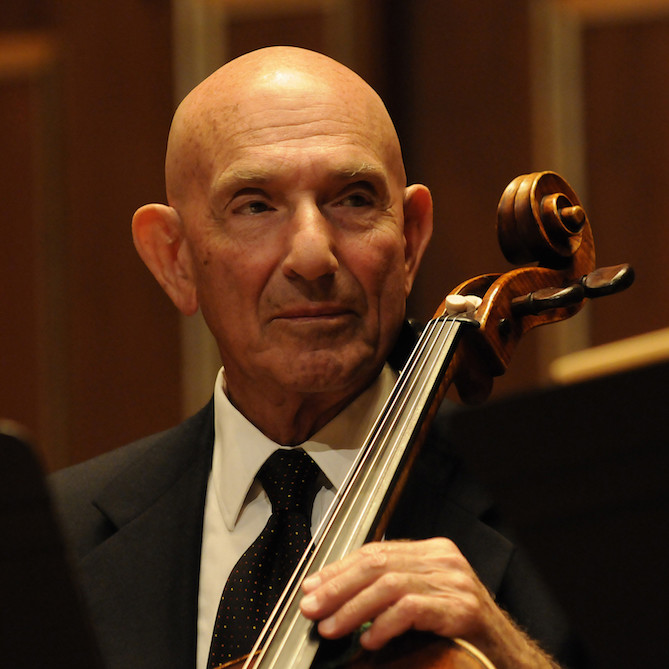Reposted from The Berkshire Eagle.
LENOX—It’s been two times 50 for Jules Eskin this summer: the conclusion of 50 years as the Boston Symphony Orchestra’s principal cellist, coinciding with the conclusion of the Boston Symphony Chamber Players’ 50th anniversary season. That automatically identifies him as a founding member of the chamber ensemble.
He’s the only founding member still in it, in fact.
Eskin, 82, is a survivor. After five months out for cancer treatments, he came back to active duty at Tanglewood on July 6 to play one of his trademark solos, the big, lyrical one in Brahms’ Second Piano Concerto. He’s also back to doing his pull-ups and sit-ups and hikes up Lenox Mountain to the fire tower, he says.
He’s tough even when it comes to producing a beautiful tone on the cello. He quotes the great cellist Gregor Piatigorsky: “You must taste the blood of that tone!”
And he plans at least one more year in the principal’s chair.
“I go day by day at my age,” he says. “I’ll see how the season goes.”
The Chamber Players, as their many followers know, are the BSO’s first-chair players. In 1964, conductor Erich Leinsdorf and then-concertmaster Joseph Silverstein came up with the idea of turning them into an ensemble of their own. They are relieved from BSO duty when the BSO turns itself into the Pops, mostly at Christmas and in the spring. They also get partial relief for their own concerts.
It wasn’t like that back in the beginning, Eskin recalls. You played BSO, Pops and Chamber Players, plus other chamber music on the side, he says.
“We did everything. We were young and strong then.”
Silverstein, who left the BSO in 1984 to forge a conducting and solo career, is still around, often seen at Tanglewood concerts. Eskin laments the death of such other founder-friends as oboist Ralph Gomberg and bassoonist Sherman Walt.
“My old buddies,” he reflects. “They all gone. It’s so sad.”
Eskin isn’t the BSO’s longest-serving member. That honor belongs to bassist Joseph Hearne, who entered at a younger age but has racked up 52 years. The record—59 years—is held by deceased violinist Rolland Tapley.
After the five-month layoff for radiation treatments for a carcinoma of the tongue, Eskin’s doctors told him to take the summer off. He’s been playing a reduced schedule but he does get tired, he says.
He’s not riding a bicycle anymore. His wife, BSO violinist Aza Raykhtsaum, forbade it for safety’s sake, he recalled in a Highwood interview.
He gave up his motorcycle some time ago but still likes to shoot a pistol at a target range. He thinks cigars—he no longer smokes—probably gave him cancer.
Eskin was born in Philadelphia. He took his first lessons from his father, a tailor and amateur cellist, and studied at the Tanglewood (then Berkshire) Music Center in 1947 and 1948. He took his first job at 16 with the Dallas Symphony Orchestra under Antal Dorati.
The Chamber Players’ anniversary is being celebrated with the release, as digital downloads, of landmark recordings made by the original members and guests for RCA during the years 1964-1968. The composers range from Mozart and Beethoven to Copland, Carter and Piston.
Eskin’s favorites among the batch include Schubert’s B-flat Trio with pianist Claude Frank, Brahms’ C-minor Piano Quartet and B-Major Trio with Richard Goode, and the Brahms and Mozart clarinet quintets with Harold Wright. He also savors the memories of group’s many tours across the United States and in Japan and Europe.
Eskin says the BSO today is very different from the orchestra he entered when Leinsdorf hired him away from the Cleveland Orchestra, where he had been principal cellist under George Szell for three years.
In Boston, chamber playing was and is “a great part of the job, which I didn’t have in Cleveland.” He also got to play string quartets and trios with his new colleagues, and concertos with the orchestra.
This BSO veteran has no crystal ball to tell where the orchestra might be going under Andris Nelsons. But, he declares, “It’s certainly gone up since I joined, in terms of quality of playing. It’s a great, great band now. No weaknesses. I don’t know how it happened, just by attrition, new people. it’s a phenomenal orchestra now, I think.”
One change takes him back to the beginning. Leinsdorf seated the cellos on the outside of the orchestra, to his right. Seiji Ozawa wanted the violas on the outside with the cellos next to them, and wouldn’t allow changes by guest conductors.
Now only the first violins are anchored and guest conductors seat the other string sections according to needs. Nelsons is reverting to the old way: cellos on the outside to his right. Veterans and newcomers alike adapt.






